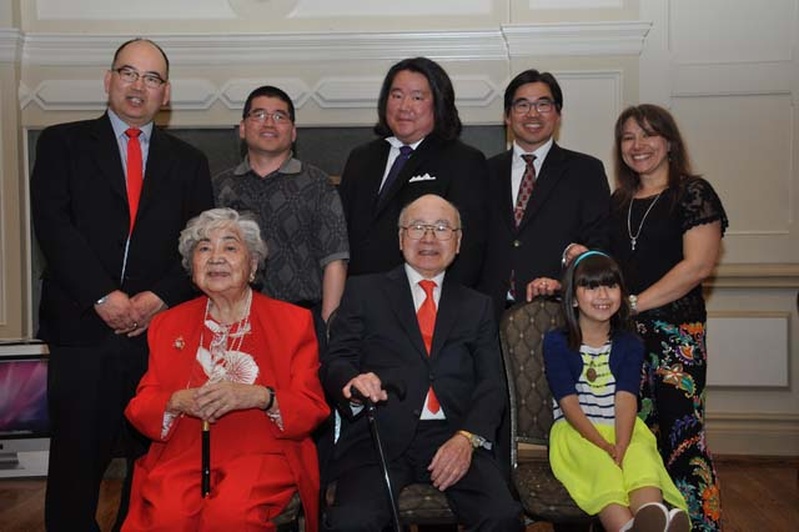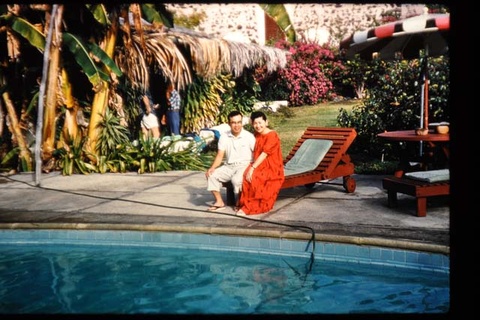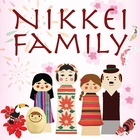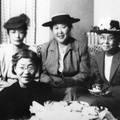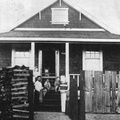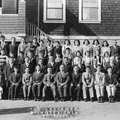My dad turned 88 this year, so we had a big party for him. Turning 88 is perhaps not so rare as it once was, but it is still a pretty big deal, especially in Japanese culture, where it is called “beiju,” meaning “rice age.” This refers to the way the characters for “eighty-eight” resemble the character for “rice,” a symbol of goodness and abundance. We were delighted that his health is still good enough to enjoy the party. To commemorate the event, I wrote up this summary of his life so far, based on his own recollections.
Salt Spring Island, BC
George was born so long ago that the tale is shrouded in legend. His birthday certificate says June 7, 1927, but his mother always claimed he was born a month earlier, on May 7, during strawberry picking time. For a long time, our family celebrated two birthdays, until a doctor friend insisted that since he was born in a hospital, the paperwork must have been done properly.
You’d think his mother Taki would know such things, but maybe it was hard to keep track, because George was their seventh child. His Japanese name, Hichiro, means seventh kid in the Yamaguchi dialect, as though his parents were just keeping inventory. His English name, George, was the name of the King of England at the time, whose picture was probably in the rooms at the Lady Minto Hospital on Salt Spring Island, BC, where he was born.
George grew up on a rented 10-acre farm on Salt Spring, where his enterprising father Shinkichi made a living growing vegetables, laundry, and cutting wood, while his mother sold moonshine to seasonal labourers. George was left to play with his younger sister Haru in a sand pit, using a piece of wood with three nails hammered into it for a car.
His mostly white childhood friends had names like Hippo, Cow, and Spider. George was known as Jeep, after the magical cartoon character in Popeye. He loved cars that are now dinosaurs and learned all their names: Durant, Whippet, Nash, De Soto, Hudson.
An annual highlight of life on Salt Spring was the July 1st celebration on the Ganges fairgrounds, which included sheep shearing contests and most importantly, races for the kids. George and other poor kids kept their eyes on the prizes of vouchers that could be cashed in at local stores for new sneakers and so on.
When George was around ten, he began working for a British family on Saturdays, removing rocks from their field for ten cents an hour. His favourite part was tea time at ten and three, with milk and cookies. He still enjoys tea at these times, even though he doesn’t have to sweat for it anymore.
Around this time, his father became ill and went back to his ancestral home on Oshima Island in Yamaguchi prefecture, where he eventually succumbed to throat cancer in 1938. Nisan (meaning older brother), as George called his eldest brother Bill, 17 years his senior, became head of the family.
Victoria, BC
About a year later, Nisan moved the family to Victoria where he had acquired a dry-cleaning business. George, his mother, and Haru, along with Nisan and his young wife and baby, started a new life in a two-bedroom apartment behind the shop.
George went to Central Junior High. Every day after regular school, he went to Japanese school, run by the Japanese United Church minister Ogura and his wife. George had not studied much Japanese before and got stuck with the little kids.
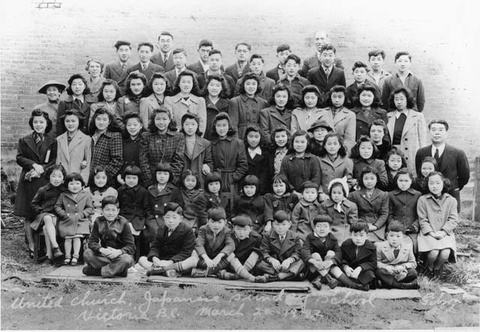
In the summer, he picked vegetables on a farm outside of Victoria run by a Nikkei named Kakuno. George saved enough money to buy his own treasured Raleigh bicycle, which he rode with his pals after Sunday school.
In early December 1941, George and his family heard the news on the radio about Japan’s attack on Pearl Harbor. George wasn’t allowed to go to school and the Japanese schools were closed. Nisan sold his business and whatever else he could for whatever they could get. In April 1942, with 72-hours’ notice, George, like the two hundred or so other Victoria Nikkei, packed up his one allotted suitcase and boarded the ship to Vancouver. He joined the hundreds of other Nikkei detained in buildings at Hastings Park. Somehow George was still able to take his bicycle.
Hastings Park, BC
George stayed with other boys between 13 and 18 in an exhibition building which still stands on the PNE grounds. He slept in one of the rows of crude wooden bunks on mattresses stuffed with straw and covered with a coarse grey blanket. He ate in a mess hall and took a correspondence course under the supervision of Nisei university students. Other boys from Victoria hung out together and for him, it was a big adventure. Sometimes they would get a pass to walk down to the big Nikkei hub on Powell Street, which according to Google maps, it would take over an hour.
Popoff, BC
In September 1942, the family took a long, smoky train ride on hard benches to Popoff, a camp near Slocan, in the interior of BC. They lived in one of the hundreds of shacks hastily built with green wood sidings. With only tar paper between the joists and planking, it was freezing in the winter. The 8' x 28' shack had three rooms. George, his mother, two sisters, and brother slept in one room with three bunk beds. On the other side, slept Nisan’s young family. And in the middle was a shared kitchen. It had a wood stove and electricity, but no plumbing, so they had to fetch pails of water for cooking and cleaning. They had an outhouse out the back.
Every morning, George walked a mile or so to the high school in Slocan city run by nuns from the Sisters of Assumption. The sisters were kind and George learned a lot. In camp, he became involved with a boys club and helped build a community centre where he did judo and other activities.
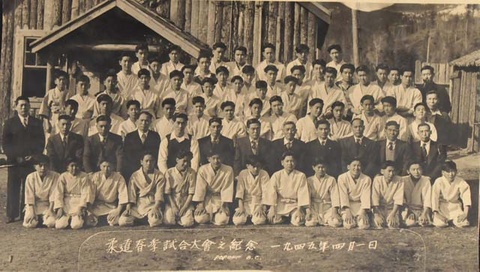
Chatham, Ontario
The war with Japan ended in 1945, but Nikkei still had their rights restricted. The federal government forced them to choose between the rocks east of the Rockies and the hard places in Japan. George was relieved his family chose to stay in Canada, despite all that had happened. They moved across the country to work on a farm in Chatham, Ontario. The whole family was hired for the dirty, back breaking work of harvesting sugar beets and other crops. George never felt clean, but at least they always had a big spread of food.
Toronto, Ontario
When restrictions to the movement of Nikkei were finally lifted in 1949, the family moved to Toronto, where Nisan found a house with three floors and nine rooms. Busy place. George found a job at Silverware Products where he worked his way into developing skills in engraving and mould making.
The most important day of George’s life was January 28, 1961, when he married Terry Yamashita. He had originally met Terry back in 1949, through his brother Gord, who was seeing Terry’s pal Harumi Tomotsugu. At some point in that first go round, George and Terry had a falling out, but as Shakespeare said, “The course of true love never did run smooth.” Eight years later, they met again by chance, at a funeral. They decided to try again and this time it took. This may be why they are always attending funerals. They splurged on a honeymoon in Hawaii and then scrambled to pay it off on their return.
Between 1962 and 1966, they had four boys. Busy times. George bought out his brother-in-law Kiichi to start his own company in acrylic embedments, which he called Clearmount Plastics. He rented a 600 square foot space with three rooms in an alley with the auspicious name of Crystal Arts Square. Terry had the office skills to set up the bookkeeping, though at first their income was still from mould making and engraving. When George actually got orders for his new business, he hired Jack Watanabe who lived at brother Bill’s place, and also brother-in-law Asakichi Ashizawa, beginning a long tradition of exploiting the sweat of family members.
On the home front, George bought a partially converted schoolbus that he finished up for camping. They enjoyed visiting places like Sand Banks Park, later Gravenhurst, and even travelled as far as New Brunswick.
With the business growing, George found a new location at 13 Musgrave near Danforth and Victoria Park. At 3,000 square feet, it seemed huge, but with the Centennial coins minted in 1967, the souvenir retail business was good.
All this hard work was not without side effects. George developed ulcers, and in 1969, while Neil Armstrong was walking on the moon, suffered a gall bladder attack. Nowadays the operation is a much more elegant procedure, but in those days, he ended up with a scar like a zipper from the middle of his chest to below his belly button. But soon he was back to business, pleased his staff were able to carry on in his absence.
After seven years at Musgrave, with rumours of the complex being sold, George found another building at River St. and Queen. It took a lot of work to renovate, but fortunately George had good Nikkei construction connections and the transition went smoothly.
In 1980, George and our family went to Japan on a tour with the Toronto Japanese Language School. This was his first visit to Japan and the villages in Yamaguchi prefecture where his parents grew up. He visited relatives living and dead and saw the family crest in the ceiling of the local temple.
Following the Redress settlement in 1988 for government injustices committed during World War II against Canadians of Japanese descent, George and Terry used their proceeds to take the family on a tour of England. A highlight for George was golfing at the legendary St. Andrews golf course in Scotland. He shot an 86 with his 15 handicap and had the score made into a plaque.
The following year, George was delighted to be able to sell off his business, after being in operation for 25 years. So at the ripe old age of 62, he retired and began a life of leisure with Terry. They began travelling in earnest, seeing many places throughout the world, including Egypt, China, and Australia. In recent years, his travel has been more of the armchair variety, but he still gets out to bowl and golf, and the old dog has been learning new tricks in the kitchen. At the party, he invited everyone to his 99th birthday party.
*This article was originally published in the Nikkei Images (Summer 2015, Volume 20, No. 2), a publication of the Nikkei National Museum & Cultural Centre.
© 2015 Raymond Nakamura


